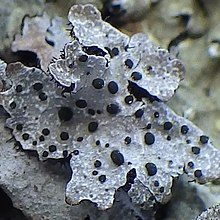Our website is made possible by displaying online advertisements to our visitors.
Please consider supporting us by disabling your ad blocker.
Lichenicolous fungus

A lichenicolous fungus is a member of a specialised group of fungi that live exclusively on lichens as their host organisms. These fungi, comprising over 2,000 known species across 280 genera, exhibit a wide range of ecological strategies, including parasitism, commensalism, and mutualism. They can be found in diverse environments worldwide, from tropical to polar regions, and play important roles in lichen ecology and biodiversity. Lichenicolous fungi are classified into several taxonomic groups, with the majority belonging to the Ascomycota and a smaller portion to the Basidiomycota. Their interactions with host lichens range from mild parasitism to severe pathogenicity, sometimes causing significant damage to lichen communities.
While the study of lichenicolous fungi dates back to the mid-18th century, recent decades have seen significant advancements through modern research methods, including molecular techniques, metagenomics, and sophisticated imaging. These fungi show varying levels of host specificity, with some species restricted to a single lichen genus or species, while others can colonise multiple hosts. A unique subset, known as lichenicolous lichens, initiates its lifecycle as parasites but eventually becomes lichenised through a process called kleptosymbiosis. Various ecological and environmental factors, including altitude, microhabitat availability, and host specificity, influence the diversity and distribution of lichenicolous fungi.
The study of lichenicolous fungi presents unique challenges due to their microscopic size and intimate association with their hosts. Researchers employ various methods, from traditional culture techniques to advanced molecular approaches. Isolating and culturing of these fungi can be difficult, often requiring specialised media and growth conditions. Molecular methods have revolutionised the field, enabling more accurate identification and phylogenetic analysis. Nevertheless, distinguishing foreign hyphae within lichen thalli from the mycobiont proper (the fungal component of the lichen) remains a significant challenge.
Recent research has broadened our understanding of lichenicolous fungi, particularly within groups such as black fungi and the genus Cladophialophora. These studies have not only revealed new species but also highlighted the potential for lichens to serve as refugia for specialised fungal organisms. Advancements in isolation techniques, culturing methods, and molecular analyses have significantly advanced the field. The actual number of lichenicolous fungal species may be much higher than currently described, potentially reaching 3,000–5,000 species.
Previous Page Next Page


